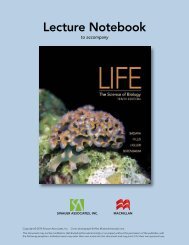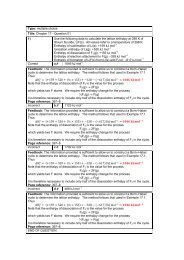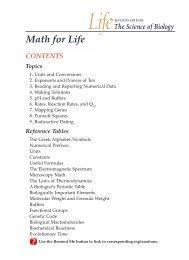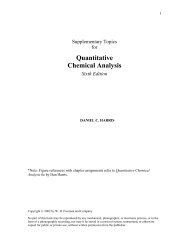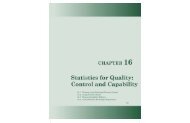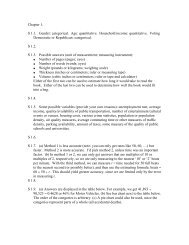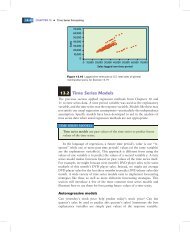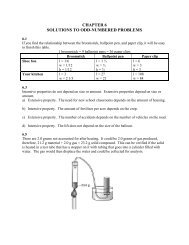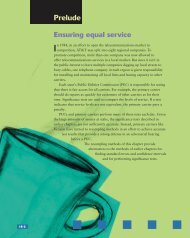SUPPLEMENTARY EXERCISES for ... - WH Freeman
SUPPLEMENTARY EXERCISES for ... - WH Freeman
SUPPLEMENTARY EXERCISES for ... - WH Freeman
- No tags were found...
You also want an ePaper? Increase the reach of your titles
YUMPU automatically turns print PDFs into web optimized ePapers that Google loves.
Section 5 37S4.36 In the language of government statistics, the “labor <strong>for</strong>ce” includes all civilians over 16years of age who are working or looking <strong>for</strong> work. Select a member of the U.S. labor <strong>for</strong>ce atrandom. Let A be the event that the person selected is white, and B the event that he or she isemployed. In 1995, 84.6% of the labor <strong>for</strong>ce was white. Of the whites in the labor <strong>for</strong>ce, 95.1%were employed. Among nonwhite members of the labor <strong>for</strong>ce, 91.9% were employed.(a) Express each of the percents given as a probability involving the events A and B; <strong>for</strong> example,P (A) = 0.846.(b) Draw a tree diagram <strong>for</strong> the outcomes of recording first the race (white or nonwhite) of arandomly chosen member of the labor <strong>for</strong>ce and then whether or not the person is employed.(c) Find the probability that the person chosen is an employed white. Also find the probabilitythat an employed nonwhite is chosen. What is the probability P (B) that the person chosen isemployed?S4.37 Use your results from the previous Exercise and the definition of conditional probabilityto find the probability P (A | B) that a randomly selected member of the labor <strong>for</strong>ce is white,given that he or she is employed. (Alternatively, you can use Bayes’s rule.)S4.38 An examination consists of multiple-choice questions, each having five possible answers.Linda estimates that she has probability 0.75 of knowing the answer to any question that maybe asked. If she does not know the answer, she will guess, with conditional probability 1/5 ofbeing correct. What is the probability that Linda gives the correct answer to a question? (Drawa tree diagram to guide the calculation.)S4.39 In the setting of the previous Exercise, find the conditional probability that Linda knowsthe answer, given that she supplies the correct answer. (You can use the result of the previousExercise and the definition of conditional probability, or you can use Bayes’s rule.)S4.40 Psychologists use probability models to describe learning in animals. In one experiment,a rat is placed in a dark compartment and a door leading to a light compartment is opened.The rat will not move to the light compartment without reason. A bell is rung and if after 5seconds the rat has not moved, it gets a shock through the floor of the dark compartment. Toavoid the shock, rats soon learn to move when the bell is rung. A simple model <strong>for</strong> learning saysthat the rat can only be in one of two states:State A: The rat will not move from the dark compartment until it receives a shock.State B: The rat has learned to respond to the bell and moves immediately whenthe bell rings.A rat starts in State A and eventually changes to State B. The change from State A to State Bis the result of learning. A rat in State A gets a shock every time the bell rings; after it changesto State B it never gets a shock. Suppose that a rat has probability 0.2 of learning each time itis shocked. Let the random variable X be the number of shocks that this rat receives. 3(a) If a rat receives exactly 4 shocks, which state was the rat in at the end of each of Trials 1,2, 3, and 4?(b) Use the result of (a) and the multiplication rule to find P (X = 4), the probability that therat receives exactly 4 shocks.



